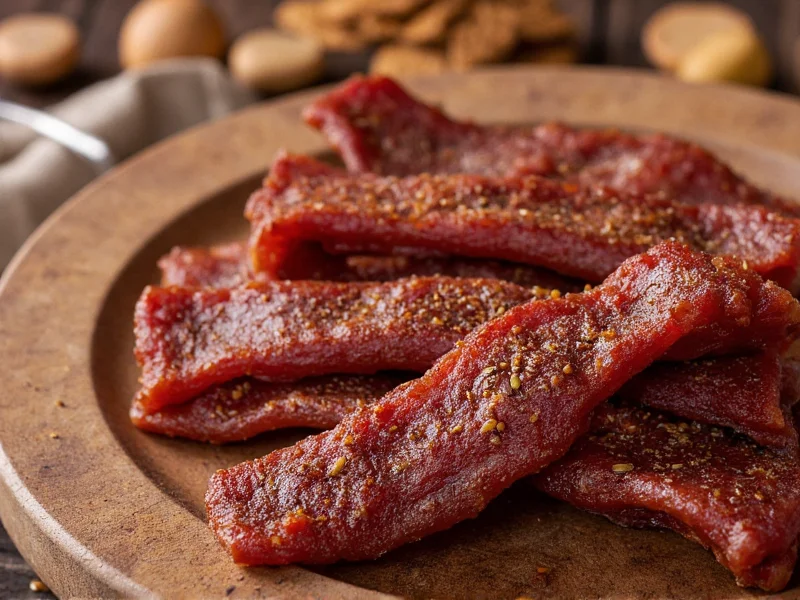Creating the perfect jerky starts with understanding the science behind effective seasoning. Jerky seasoning serves multiple critical functions: it enhances flavor, aids in preservation, and contributes to the distinctive texture that makes jerky so appealing. Unlike regular spice rubs, jerky seasoning must balance taste with food safety requirements for dried meat products.
Essential Components of Jerky Seasoning
Every successful jerky seasoning blend contains specific elements that work together to create safe, flavorful dried meat. Understanding these components helps you create consistently excellent results whether you're making traditional beef jerky, turkey jerky, or alternative protein varieties.
Salt: The Preservation Foundation
Salt isn't just for flavor—it's essential for jerky's preservation. Sodium draws moisture from meat through osmosis, creating an environment where bacteria cannot thrive. For traditional jerky, use non-iodized salt like kosher or sea salt. The minimum recommended amount is 1/4 cup per pound of meat, though some recipes may require more depending on drying conditions and meat thickness.
Sugar: Flavor Balance and Caramelization
Sugar balances saltiness and promotes surface caramelization during drying. Brown sugar adds molasses notes, while white sugar provides cleaner sweetness. Honey or maple syrup can be used in marinades but should be applied sparingly to prevent burning. The standard ratio is 2 tablespoons of sugar per pound of meat, though sweeter profiles might use up to 1/4 cup.
Spices: Flavor Complexity
Basic jerky seasoning includes garlic powder and black pepper as foundational spices. Garlic powder provides savory depth without the moisture of fresh garlic, while freshly ground black pepper delivers consistent heat. Other common additions include:
| Spice | Flavor Contribution | Recommended Amount (per lb meat) |
|---|---|---|
| Onion powder | Earthy sweetness | 1-2 teaspoons |
| Red pepper flakes | Controlled heat | 1/2-1 teaspoon |
| Paprika | Smoky depth | 1-2 teaspoons |
| Liquid smoke | Smoked flavor (no smoker needed) | 1/2-1 teaspoon |
Curing Agents: Food Safety Essentials
For safe jerky production, especially when using home dehydrators or ovens, curing salt is non-negotiable. Prague Powder #1 (also called pink curing salt) contains sodium nitrite which prevents botulism and fixes the meat's color. Use exactly 1 teaspoon per 5 pounds of meat—never more, as nitrite can be toxic in higher concentrations. This ingredient is what separates proper jerky seasoning from regular meat rubs.
Creating Your Own Jerky Seasoning Blend
Customizing your jerky seasoning allows you to develop unique flavor profiles while maintaining food safety standards. Start with this basic framework and adjust to your taste preferences:
Classic Jerky Seasoning Base Recipe
- 1/4 cup non-iodized salt (for curing)
- 2 tablespoons brown sugar
- 1 tablespoon garlic powder
- 1 tablespoon freshly ground black pepper
- 1 teaspoon onion powder
- 1 teaspoon red pepper flakes (adjust for heat preference)
- 1 teaspoon Prague Powder #1 (curing salt)
Flavor Variations to Explore
Once you've mastered the basic blend, experiment with these popular variations:
Teriyaki Jerky Seasoning
Add 2 tablespoons soy sauce, 1 tablespoon ginger powder, and 1 tablespoon sesame oil to the base recipe. Reduce sugar to 1 tablespoon as soy sauce adds sweetness.
Spicy Chipotle Blend
Replace regular paprika with 2 tablespoons chipotle powder and add 1 teaspoon cumin. Increase red pepper flakes to 1.5 teaspoons for extra heat.
Montreal Steak Seasoning Style
Add 2 tablespoons cracked peppercorns, 1 tablespoon dried rosemary, and 1 tablespoon coriander seed to the base recipe for a coarse, aromatic blend.
Proper Application Techniques
How you apply seasoning significantly impacts final flavor. For best results:
- Mix dry seasoning thoroughly before applying
- Cut meat against the grain for tender jerky or with the grain for chewier texture
- Coat meat strips evenly, massaging seasoning into surface
- Refrigerate marinated meat for 4-24 hours (longer for thicker cuts)
- Pat dry before placing in dehydrator to prevent steaming
Troubleshooting Common Jerky Seasoning Issues
Even experienced jerky makers encounter problems. Here's how to fix common seasoning-related issues:
Overly Salty Jerky
If your jerky tastes too salty, you've likely used too much curing agent or didn't marinate long enough. Reduce salt by 10-15% in your next batch and ensure proper marinating time (minimum 4 hours) allows flavors to penetrate rather than just coat the surface.
Bland Flavor After Drying
Drying concentrates flavors, but sometimes results in bland jerky. This usually means insufficient seasoning or uneven coating. Increase seasoning by 20% and ensure thorough mixing. Consider adding a small amount of acid (like 1 teaspoon citric acid) to brighten flavors that get muted during drying.
Burning or Bitter Taste
Sugars and certain spices can burn at dehydrator temperatures. Reduce sugar content slightly and avoid spices that burn easily like cumin in large quantities. If using liquid ingredients like soy sauce or honey, reduce other liquids proportionally to maintain proper drying characteristics.
Storage Guidelines for Homemade Seasoning
Properly stored, homemade jerky seasoning maintains potency for 6-12 months. Keep these tips in mind:
- Store in airtight glass or metal containers (plastic can absorb flavors)
- Keep away from heat sources and direct sunlight
- Label with creation date and recipe name
- For long-term storage, freeze in vacuum-sealed bags
- Check for clumping or off odors before use
Advanced Jerky Seasoning Techniques
For those looking to elevate their jerky game, consider these professional techniques:
Dual-Stage Seasoning
Apply half the seasoning before marinating, then the remainder after partial drying. This creates layered flavor that penetrates deeply while maintaining surface seasoning.
Smoke Infusion During Drying
Add wood chips to electric dehydrators or use liquid smoke sparingly during the final drying stage for authentic smoked flavor without specialized equipment.
Acid Balance for Tenderization
Incorporate small amounts of acid (1-2 teaspoons per pound of meat) like Worcestershire sauce, vinegar, or citrus juice to help tenderize tougher cuts while enhancing flavor complexity.











 浙公网安备
33010002000092号
浙公网安备
33010002000092号 浙B2-20120091-4
浙B2-20120091-4